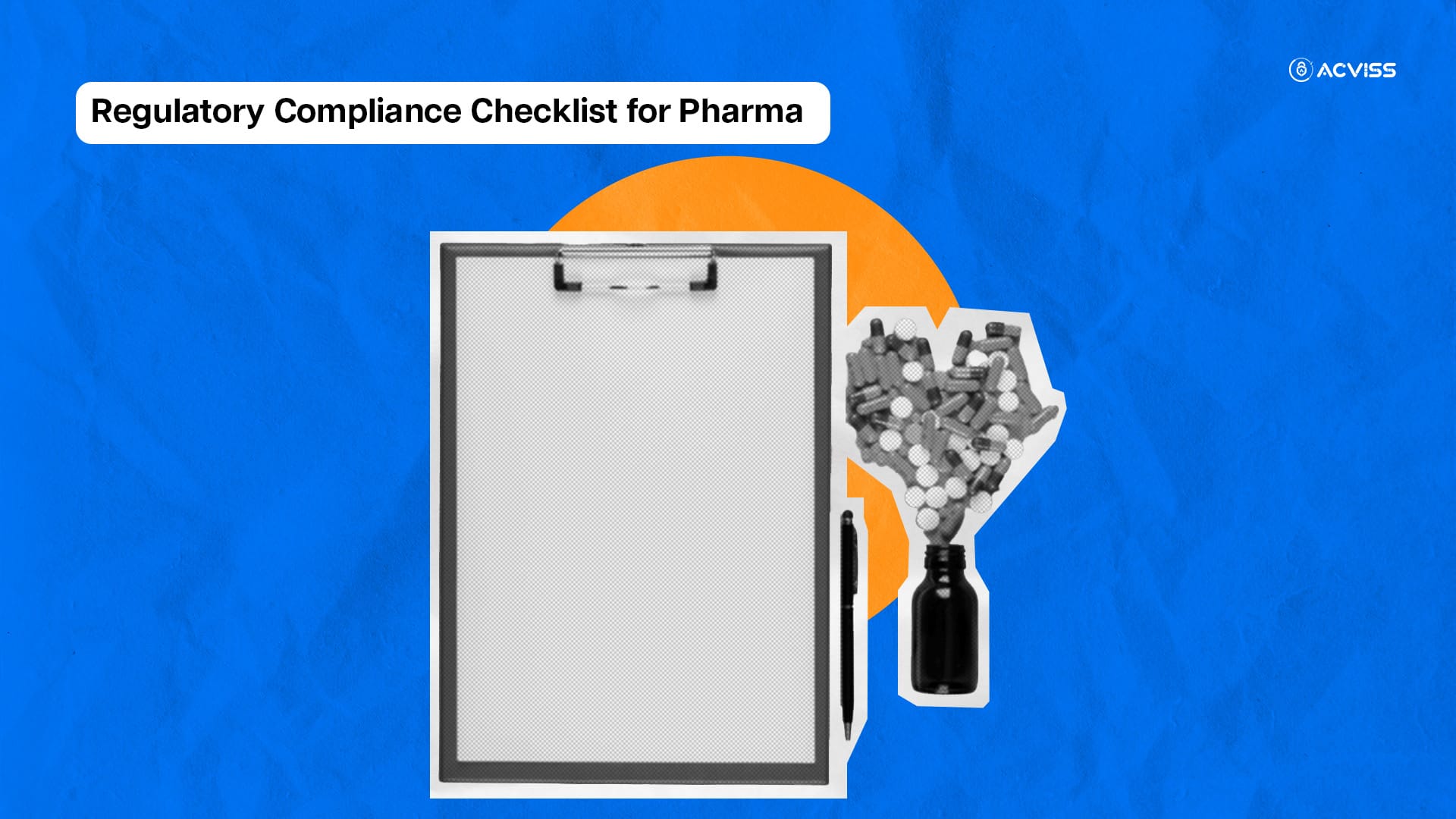Regulatory Compliance Checklist for Pharma: A Practical Guide to Navigating Complex Demands

Pharmaceutical companies operate in one of the most tightly regulated industries in the world and we all know why. This means as a pharma company if you don’t comply with any of the rules the impact is not just the financial penalties but way more than that. It can result in product recalls, halted production lines, patient harm, and irreparable damage to brand reputation.
India’s pharmaceutical industry alone is projected to reach $130 billion by 2030, and this is because of all the exports, innovation, and increasing healthcare demands. As the industry grows, the expectations of regulators around the globe like US FDA, EU EMA and India’s CDSCO also grows.
The average cost of a single compliance violation stands at $14.8 million, and this does not include litigation, lost revenue, or delayed approvals. On the other hand, if you make sure everything is compliant it not only avoids penalties but it builds market trust and opens up access to high-value global markets.
In this blog, we will break down region-specific checklists, key regulations, and digital traceability solutions to help pharma companies, especially MSMEs and exporters to navigate compliance in 2025 and beyond.
Core Pillars of Pharmaceutical Compliance
Regulatory frameworks vary from country to country, but foundational pillars of pharmaceutical compliance are mostly the same. Here are the five core areas every pharma manufacturer must master:
1. Good Manufacturing Practices (GMP):
These form the backbone of pharmaceutical production. GMP ensures that products are consistently produced and controlled according to quality standards. It covers everything from hygiene to equipment calibration and environmental monitoring.
2. Quality Assurance & Documentation:
Quality isn’t just about testing the final product. It's embedded in every stag from raw material sourcing to packaging. Comprehensive documentation (like SOPs, batch records, and training logs) ensures traceability, accountability, and audit-readiness.
3. Batch Traceability & Product Recalls:
Traceability allows manufacturers to track a product’s journey across the supply chain. In the event of a defect, this enables quick and targeted recalls, minimizing risk to patients and brand reputation.
4. Labelling & Serialization:
Mislabelling is a major cause of product recalls. Product serialization assigning a unique code to each product unit helps prevent counterfeiting, simplifies global supply chain compliance, and supports regulatory reporting.
5. Pharmacovigilance:
Post-market surveillance is critical for identifying adverse drug reactions and maintaining public safety. Regulatory bodies expect robust systems to monitor, analyze, and report side effects promptly.
These pillars ensure not only compliance but also product safety, efficacy, and trustworthiness.

Core Pharmaceutical Compliance Requirements
Global pharmaceutical regulations are built on a web of overlapping standards and frameworks. Here are some of the most crucial ones companies must comply with:
- GMP (Good Manufacturing Practices)
- GCP (Good Clinical Practices)
- GDP (Good Distribution Practices)
- 21 CFR Part 11 (US FDA: Electronic Records and Signatures)
- Annex 11 (EU: Computerized Systems in GMP Environments)
Beyond these, 2025 is seeing significant regulatory and operational shifts that pharma companies cannot afford to ignore:
1. Real-time Monitoring:
With 32% of pharma companies already adopting real-time monitoring tools, regulators are now expecting more live data capture across production and logistics to identify issues proactively.
2. AI in Compliance Tasks:
Around 45% of global pharma firms are using AI to automate documentation, audit preparation, and anomaly detection, freeing up compliance teams and reducing human error.
3. Sustainability Compliance:
With 80% of pharma companies expected to be impacted by new environmental mandates by 2030, eco-compliance (waste disposal, green packaging, carbon reporting) is now integral to regulatory planning.
One consistent requirement across all frameworks is the need for a Quality Management System (QMS). A QMS enables centralized control of documents, SOPs, CAPA logs, training, and compliance workflows.
Regulatory Compliance Checklist for Indian Pharma (CDSCO)
India’s pharmaceutical regulatory authority, the Central Drugs Standard Control Organization (CDSCO), plays a critical role in ensuring that drugs manufactured, sold, or distributed across India meet safety and quality standards.
CDSCO’s Core Responsibilities:
- Approval of new drugs and clinical trials
- Regulation of drug manufacturing and imports
- Monitoring pharmacovigilance and post-market safety
Key Compliance Requirements for Indian Pharma Companies:
1. Schedule M Compliance:
Mandatory adherence to Good Manufacturing Practices (GMP), covering facility design, hygiene, documentation, and quality control.
2. Traceability Mandate (2023 Onward):
All pharma packs, particularly exports, must include QR codes or barcodes for product-level traceability. This aligns with global serialization standards.
3. Legal Metrology & BIS Packaging Standards:
All pharma products must comply with label accuracy rules (weights, expiry, dosage, etc.) as per Legal Metrology Act and BIS standards.
4. Pharmacovigilance Programme of India (PvPI):
Requires continuous reporting of adverse drug reactions (ADRs), with documentation aligned to CDSCO’s risk monitoring framework.
⭐ Pro tip: CDSCO compliance is not just about satisfying Indian law, it’s becoming a prerequisite for export to the US, EU, and ASEAN nations. |
|---|
US FDA Compliance Checklist for Pharmaceutical Industry
The US Food and Drug Administration (FDA) is globally recognized for its rigorous pharmaceutical standards. Non-compliance can lead to import bans, product recalls, and even criminal penalties.
Must-Follow Regulations:
1. Current Good Manufacturing Practice (CGMP) – 21 CFR Parts 210 & 211
These cover every aspect of drug production: cleanliness, personnel hygiene, equipment validation, and written procedures.
2. 21 CFR Part 11 – Electronic Records and Signatures
Ensures that all digital documentation is secure, auditable, and tamper-proof, especially in automated manufacturing or inventory systems.
3, FSMA 2026 Traceability Rule
Under the Food Safety Modernization Act, stricter serialization and track-and-trace protocols will be mandatory by 2026, even for pharma ingredients.
What You Can’t Miss:
- Risk-Based Inspections: The FDA prioritizes companies based on past violations or flagged risks, often triggered by poor documentation or inconsistent records.
- Form 483 Observations: Issued after inspections, these highlight compliance gaps. Companies that respond quickly reduce penalties by up to 92%.
EU EMA Pharma Compliance Standards
The European Medicines Agency (EMA) regulates pharmaceutical products across EU member states, focusing heavily on patient safety, digital records, and traceability.
Key EMA Guidelines to Know:
1. EU GMP Part I & II:
Cover manufacturing processes (Part I) and active substances (Part II), similar to US FDA CGMP but with greater emphasis on environmental controls.
2. Annex 11 – Computerized Systems:
Requires companies to validate all computerized processes for data integrity, audit trails, and secure backups.
3. Falsified Medicines Directive (FMD):
Enforces serialization through 2D data matrix barcodes and tamper-evident packaging to fight counterfeit drugs in Europe.
4. EudraVigilance for Pharmacovigilance:
A centralized platform where companies must report adverse drug reactions. EU firms must maintain consistent timelines and formats for submissions.
Brexit Note:
UK-based pharma exporters must comply with both MHRA and EMA regulations, often needing duplicate documentation and quality checks.
💡Did You Know?
|
|---|
Regulatory Audit Checklist for Pharma
Whether it’s CDSCO in India, the US FDA, or the EU EMA, a clean audit can open markets, while a failed one can halt production.
Here’s a smart audit preparation checklist:
- Facility & Equipment: Cleanrooms, calibrated tools, validated machines
- Documentation: Up-to-date SOPs, batch records, CAPA logs
- Training: Logs for employee certifications and compliance refreshers
- Traceability Systems: Serialized packaging, audit trails, tamperproof records
- Digital Logs: Must be 21 CFR Part 11 and Annex 11 compliant
⭐Pro tip: Regular mock audits reduce your chances of receiving a Form 483 or warning letter by over 90%. |
|---|
GMP Compliance Checklist

Good Manufacturing Practices (GMP) form the bedrock of every compliant pharma operation. Regulators worldwide look for evidence that you’re not just meeting GMP on paper but following it every day.
GMP Checklist Essentials:
- Raw Material Sourcing: Only from certified suppliers with CoAs (Certificates of Analysis)
- Batch Manufacturing Records: Real-time entries, signed, verified, stored securely
- Validation Protocols: In-process checks, line clearance, cleaning validation
- Deviation Management: Documented root cause analysis, corrective actions, and effectiveness review
- Quality Culture: Ongoing employee training, internal audits, and digital QMS systems
Digital Impact:
→ 85% of companies using digital QMS tools report faster issue resolution and reduced deviation cycles.
→ QR code-based traceability reduces manual errors by up to 95%, a must for modern GMP audits.
Pharma Traceability and Supply Chain Track and Trace
Traceability is very essential in the global pharma landscape. Whether it’s tracking a recalled batch or validating the authenticity of a blister pack, traceability directly impacts patient safety, brand credibility, and operational control.
Why traceability matters:
- Enables faster product recalls and root cause analysis
- Detects counterfeit infiltration in real time
- Meets compliance mandates in India (CDSCO), US (FSMA), and EU (FMD)
Technologies enabling end-to-end track & trace:
- QR codes: Used for unit-level identification and anti-counterfeiting
- RFID: Often used in warehousing and high-speed logistics
- Blockchain: Provides tamper-proof records and cross-border supply chain transparency
💡Did you know? Over 62% of pharma companies struggle with end-to-end visibility in their supply chains, especially SMEs managing multi-country logistics. |
|---|
Examples in action:
- Everledger: Uses blockchain to track high-value products like diamonds and wines, now extending to pharma-grade products.
- Scantrust: Combines QR code-based serialization with cloud tracking, popular among global pharma exporters.
Track and Trace Compliance: Global Expectations
Pharmaceutical compliance today is no longer confined within national borders. Countries now demand product-level serialization and real-time tracking as baseline expectations not value-adds.
Key Global Requirements:
- US FDA DSCSA: Mandates serial numbers and verification at the unit level
- EU Falsified Medicines Directive (FMD): Requires tamper-evident features and safety seals
- India’s CDSCO: Introduced QR code rules for APIs and finished drugs (2023 onward)
Serialization Mandates Exist At Every Packaging Level:
- Unit (bottle/blister strip)
- Secondary (carton)
- Tertiary (case/pallet)
Technology stack used:
- Barcodes / QR codes for packaging-level serialization
- RFID tags for logistics and bulk shipments
- Cloud-based dashboards for live batch monitoring and recalls
Global pharma exports with no serialization face immediate rejection, especially in the EU and US.
India-Specific Compliance Landscape
India is one of the top five pharmaceutical exporters globally, but its MSME-heavy industry presents unique compliance hurdles.
Quick facts:
- Over 70% of Indian pharma units are MSMEs
- Export-oriented companies are increasingly judged on FDA, EMA, and PIC/S standards
- In 2023, CDSCO mandated QR codes for 300+ branded drugs to tackle spurious medicine sales
Challenges unique to India:
- Low adoption of digitized QMS and serialization tools
- Limited training around global compliance standards
- Fragmented records across paper, Excel, and legacy ERP
Impact:
India loses over INR 1 trillion annually due to counterfeit and substandard drugs, both domestically and in exports.
Challenges and How to Stay Ahead
The biggest challenge for pharma companies, especially MSMEs, is keeping up with evolving standards across jurisdictions.
Top Compliance Challenges:
1. Frequent Rule Updates: Over 15% of US FDA guidelines changed in 2025 alone
2. Global Variability: Different mandates from CDSCO, EMA, US FDA
3. Manual Systems: Prone to errors, duplication, and missed validations
4. High Costs: Advanced serialization tools often priced out of MSME budgets
5. Training Gaps: Lack of regulatory awareness among staff
6. Export Risks: Batches rejected due to lack of compliance or serialization
Solution:
The solution to this is Digitization. Paper logs, siloed spreadsheets, and reactive audits won’t cut it. Cloud-based, secure, traceable solutions are becoming the new industry norm.
How Acviss Simplifies Pharma Compliance and Traceability

- Deploys non-cloneable QR codes on every bottle, carton, or case
- Complies with India’s CDSCO QR code rule, the US DSCSA, and EU FMD
- Prevents counterfeiting and enables end-to-end product verification
- Blockchain-powered platform that captures every change across the batch lifecycle
- Creates audit-ready documentation, free from tampering or data loss
- Enables CAPA visibility, training logs, and SOP traceability, all in one place
Impact Highlights:
- Up to 54% fewer compliance failures caused by manual errors
- Full traceability from raw materials to final distribution
- Works for both small-scale manufacturers and large-scale exporters
Acviss solutions are modular. Start with serialization, scale into full QMS traceability over time.
Final Thoughts
In pharma, compliance isn’t a box to check. It is more of a process to build. With regulations constantly evolving and exports growing more competitive, brands need to shift from reactive to proactive systems.
Here’s the mindset to keep:
- Start small, digitize batch records and SOPs
- Add serialization with QR codes as per CDSCO/FDA mandates
- Invest in real-time traceability and blockchain-led audit trails
- Train your team, audit often, stay updated
Why it matters:
Compliance ensures patient safety, brand credibility, and global market access.
Brands that invest in traceability today are tomorrow’s trusted global exporters.
Frequently Asked Questions
1. Do small Indian pharma companies need to comply with international rules?
Yes. If you export, you must comply with FDA, EMA, or other region-specific regulations, in addition to CDSCO. Non-compliance may lead to rejections or penalties.
2. What’s the deadline for QR code compliance under CDSCO?
CDSCO made QR codes mandatory from August 2023 for select products. However, it's recommended exporters adopt serialization for future readiness.
3. Is blockchain necessary for pharma compliance?
It’s not mandatory, but blockchain strengthens traceability, ensures tamper-proof audit trails, and simplifies global regulatory audits, especially for exports.
4. What documents are usually checked in a pharma audit?
Batch records, SOPs, CAPA logs, training records, equipment validation reports, and serialization data are commonly reviewed by auditors.
5. How can I reduce human error in pharma compliance?
Digitize processes using QR codes, electronic batch records, and automated audit logs. This reduces manual entry mistakes and ensures data integrity.
